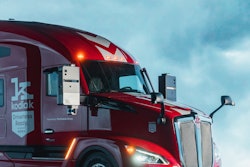Trucking news and briefs for Tuesday, April 23, 2024:
New state law establishes heavy-duty towing guardrails, bans boots and other devices
Mississippi Gov. Tate Reeves on April 19 signed a bill into law that aims to cut down on predatory towing practices targeting commercial vehicles in the state. With the new law, Mississippi joins Maryland, Florida, and other states that have recently made similar efforts to rein in egregious rates and other predatory practices.
The new law establishes a Commercial Vehicle Towing Advisory Committee within the state’s Department of Public Safety’s Public Commercial Transportation Enforcement Division. That committee is charged with:
- Establishing regulations and standards for the inclusion of a towing and recovery service on the tow list, including application procedures and minimum qualification requirements
- Establish statewide maximum towing and storage rates for nonconsensual tows, including those for private property
- Require towing and recovery services to ban the use of per-pound billing for nonconsensual towing
- Publish a Towing Service Standard Manual, with rules governing the use of towing and recovery services for nonconsensual towing of commercial vehicles
[Related: DOT's Buttigieg, FMCSA call out predatory towing, propose penalties]
“Predatory towing is an egregious practice that not only disrupts our state’s supply chain, but also costs Mississippi truck owners thousands of dollars for each unwanted tow,” said Mississippi Trucking Association President Hal Miller. “We are grateful to Mississippi legislators for listening to our concerns about this unfair tactic, and we thank Gov. Reeves for swiftly signing this bill into law.”
The law defines “nonconsensual towing” as “the moving, transporting or recovery of a commercial vehicle by a towing and recovery service without the prior consent or authorization of the owner or operator of the motor vehicle from private property and/or by police-initiated towing,” which should cover not only roadside emergency tows but also parking-enforcement tows. The new law prohibits towing and recovery services from using vehicle immobilization devices, such as boots, unless directed to by law enforcement.
The law also requires that when a vehicle is nonconsensually towed to a storage facility, the towing service will allow a vehicle owner or designee of the owner to access the vehicle to collect personal property, “regardless of whether any payment has been made for the towing and recovery service charges.”
[Related: Trucking's best defense against predatory towing: A step-by-step guide]
Towing and recovery services will also be required to document the vehicle’s condition and reason for towing before hooking up to the vehicle for a nonconsensual tow, and to take multiple photographs from different angles, which can be provided to the truck owner by request.
The law goes into effect on July 1.
[Related: Predatory towing: How common it is, and how truckers can avoid it]
Senators urge NHTSA to create automated driving system standards
A group of Senators last week penned a letter to the National Highway Traffic Safety Administration urging the agency to be more proactive and aggressive in addressing safety concerns related to automated driving technologies.
Sens. Edward Markey (D-Massachusetts) and Richard Blumenthal (D-Connecticut) authored the April 18 letter, which was cosigned by Sens. Elizabeth Warren (D-Massachusetts), Bernie Sanders (I-Vermont), Ben Ray Luján (D-New Mexico), and Peter Welch (D-Vermont).
The senators noted “several high-profile crashes” in the last few months that “have highlighted the risks that vehicles equipped with partially automated and Automated Driving Systems (ADS) pose for road users.” They added that NHTSA has initiated several investigations but has not taken further proactive steps to make these systems safe enough for U.S. roads.
“We cannot allow partially automated driving systems and automated driving systems to accelerate the road safety crisis,” the senators wrote in the letter. “NHTSA must take firm control of the wheel and steer manufacturers towards prioritizing safety.”
[Related: FMCSA to study 'human-ADS' teams?]
They added that “public roads are not a sandbox for manufacturers or operators to play in, and regulatory agencies like NHTSA should be highly cautious about providing lax pathways onto the road for dangerous vehicles.”
Specifically, the letter urges NHTSA to consider several policy actions that would make autonomous vehicles safer, including:
- Restrict driving systems to the roads they are designed for. Partially and fully automated driving systems are designed only for certain road environments, but some manufacturers allow these systems to be engaged anywhere.
- Investigate confusing marketing that misleads drivers, as partially automated driving systems are sometimes marketed as automated driving systems, leading to dangerous situations where drivers misunderstand the driving system’s capability.
- Explore requiring more robust data collection. Vehicle manufactures are required to provide crash data to NHTSA for certain crashes, but this data is often incomplete and insufficient to inform potential regulatory safety actions.
- Consider proactive standards to make autonomous vehicles safer. Outside of the Federal Motor Vehicle Safety Standards that every vehicle must comply with, there is no additional safety standard automated driving systems must meet to ensure the vehicles are safe enough for public roads.
- Regulate remote assistance operators. Many automated driving systems rely on remote assistance operators to monitor the driving system, but there are no standards governing the credentials, location, or responsibilities of these operators.
- Exercise significant caution before exempting autonomous vehicles from existing safety standards.
[Related: Will autonomous trucks displace drivers? Congress holds hearing on impacts]
Truck tonnage fell in March
The amount of freight hauled by trucks in March was down 1% year over year and down 2% from February, according to the American Trucking Associations’ advanced seasonally adjusted For-Hire Truck Tonnage Index. The 2% decline from February follows a 4% increase in February from January.
In March, the index equaled 113.4 compared with 115.7 in February.
“Tonnage in March suggests that truck freight volumes remain lackluster, and it is clear the truck freight recession continued through the first quarter,” said ATA Chief Economist Bob Costello. “In the first three months of 2024, ATA’s tonnage index contracted 0.8% from the previous quarter and declined 2.4% from a year earlier, highlighting ongoing challenges the industry is navigating.”
Compared with March 2023, the index fell 1%, which was the 13th straight year-over-year decline, but the second smallest over that period. In February, the index was down 1.7% from a year earlier.
The not seasonally adjusted index, which represents the change in tonnage actually hauled by the fleets before any seasonal adjustment, equaled 114.4 in March, 4.7% higher than in February. ATA’s For-Hire Truck Tonnage Index is dominated by contract freight as opposed to spot market freight.








